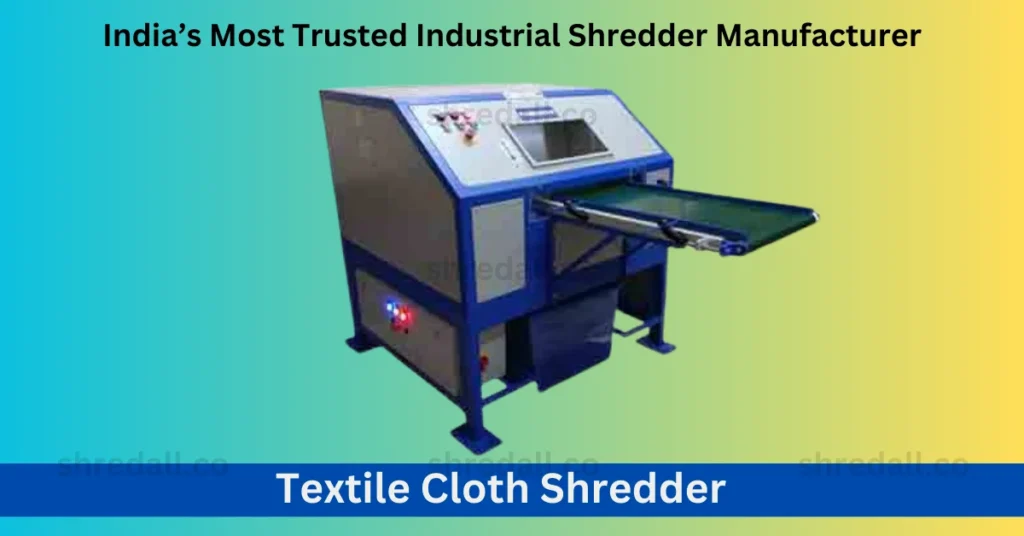Introduction: Textile Cloth Shredder
Wellcome to Shredall In the ever-changing landscape of waste management, companies are constantly looking for innovative solutions to solve environmental problems. One such area of focus is textile waste management, which contributes significantly to global waste disposal problems. In this blog post, we’ll delve deeper into the world of fabric and clothing disassembly, exploring its importance, efficiency and positive impact on sustainable waste.
The challenge of fabric waste: Textile Cloth Shredder
The fashion and fashion industry is known for fast trends and constantly changing trends. Unfortunately, this fast pace of nature contributes to the staggering amount of fabric waste. Disposal methods such as landfill or incineration pose significant environmental challenges and require sustainable alternatives.

Enter the fabric coat shredder: Textile Cloth Shredder
Textile disassembly has emerged as a game changer in textile waste management. These powerful machines are designed to efficiently and effectively separate a variety of textile materials such as fabrics, textiles and woven materials and the scraps can then be recycled in a variety of ways, contributing to the circular economy.
How Textile Cloth Shredders Work:
Material Feeding: Textile materials are fed into the shredder, in which effective blades or reducing mechanisms start the manner.
Shredding Process: The machine makes use of its reducing generation to interrupt down the textiles into smaller, more achievable pieces. This can range from best fibers to larger chunks, depending on the system’s specs.
Output Collection: The shredded material is accumulated, prepared for similarly processing or repurposing. The length and consistency of the output can be adjusted primarily based on particular necessities.
Advantages of Textile Cloth Shredders
Waste Reduction: Perhaps the most important advantage is the substantial reduction in textile waste. Shredding clothing not only reduces the amount of waste but also makes it easier to handle and transport.
Resource Recovery: Scrapped textile materials can be repurposed for a variety of uses, such as insulation, filling for furniture, or even as raw materials for new clothing This resource recovery contributes to a more sustainable and circular approach to production.
Energy efficiency: Modern fabric shredders are designed with energy efficiency in mind. They often incorporate advanced technologies to reduce energy consumption, while maximizing output.
Environmental Impact: Textiles from landfill and incineration Textile textile shredders play an important role in reducing the environmental impact associated with textile waste This is in line with global efforts to combat and promote climate change
Challenges and Considerations: Textile Cloth Shredder
Material Compatibility: While textile shredders can handle a wide range of materials, some considerations must be made regarding material compatibility with specific shredding technologies. Maintenance: Regular maintenance is essential to ensure optimum performance of shredder machines. This includes sharpening the blade, inspecting and fixing any malfunctions.
Conclusion: Textile Cloth Shredder
Textile disassembly represents a beacon of hope in the quest for better waste management in the textile industry. As awareness of the environmental impacts of textile waste increases, investments in alternative solutions, such as shredding, are needed. By adopting this technology, businesses can not only reduce the effects of textile waste, but also contribute to a circular and environmentally conscious future. It’s time for the textile industry to rip off its old habits and weave a new narrative of sustainability.
You May Also Like to Know about our below featured products.
Double Shaft Municipal solid waste Shredder
FMCG rejected Products Shredder Destroyer-2024
Frequesntly Asked Question about Texrile Cloth Shredder.
- What is a textile cloth shredding machine?
- A textile cloth shredding machine is a mechanical device designed to shred or cut various types of textile materials into smaller pieces. It is commonly used in industries dealing with textile waste recycling.
- What types of textiles can be shredded using these machines?
- Textile cloth shredding machines can handle a wide range of materials, including cotton, polyester, wool, nylon, denim, and other fabric types.
- Why use a textile shredding machine?
- These machines are used to efficiently process textile waste, making it easier to recycle and repurpose materials. Shredding textiles reduces their volume, aids in waste management, and facilitates the extraction of valuable fibers for reuse.
- What are the main components of a textile shredding machine?
- The main components typically include a feeding mechanism, cutting or shredding blades, a motor, and a control system. Some advanced models may have additional features such as safety mechanisms and automated controls.
- How does the machine handle different textile thicknesses?
- Textile shredding machines are often adjustable to accommodate various thicknesses of materials. Users can typically adjust the settings to optimize shredding performance based on the specific type and thickness of textiles being processed.
- Can these machines handle mixed materials, such as blends of different fabrics?
- Most textile shredding machines are designed to handle mixed materials to some extent. However, separation of materials before shredding is recommended for better efficiency and recycling outcomes.
- What safety measures should be taken when operating a textile shredding machine?
- Users should follow safety guidelines provided by the manufacturer, including wearing appropriate protective gear, ensuring proper machine maintenance, and following proper operating procedures. Emergency stop features are often incorporated for safety.
- Is maintenance required for textile shredding machines?
- Regular maintenance is essential to ensure the proper functioning of the machine. This may include blade sharpening or replacement, lubrication of moving parts, and inspections to identify and address any wear or damage.
- Can shredded textiles be recycled?
- Yes, shredded textiles can be recycled. After shredding, the materials can undergo further processing to extract fibers for reuse in various applications, such as the production of new textiles or insulation materials.
- What is the capacity of these machines?
- The capacity of textile shredding machines varies depending on the model and specifications. Capacities can range from small-scale machines suitable for businesses or workshops to larger industrial-scale machines capable of handling significant volumes of textile waste.


